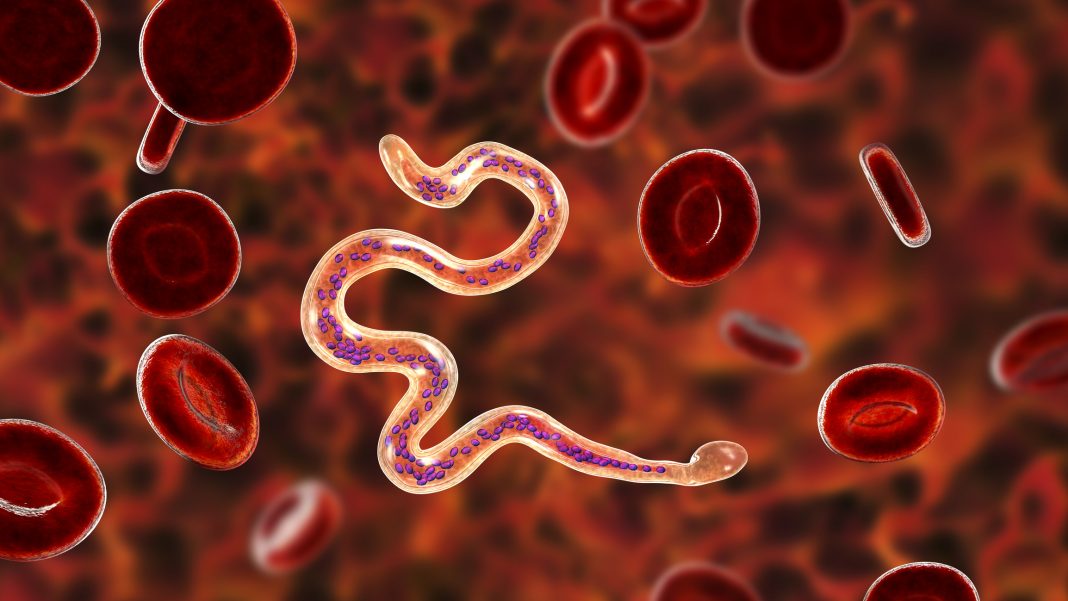Lymphatic filariasis is a disease spread by mosquitoes infected with one of three filarial nematodes. In an effort to better understand the transcriptomic interplay of organisms associated with lymphatic filariasis, a research team from the University of Maryland School of Medicine (UMSOM) Institute for Genome Sciences conducted multispecies transcriptome sequencing (RNA-Seq) on Brugia malayi (one of the three filarial nematodes), its bacterial Wolbachia endosymbiont, and the mosquito vector Aedes aegypti across the entire B. malayi life cycle. The team identified a promising novel treatment for lymphatic filariasis, a disabling parasitic disease that is difficult to treat.
The study is published in a paper titled, “Drug Repurposing of Bromodomain Inhibitors as Potential Novel Therapeutic Leads for Lymphatic Filariasis Guided by Multispecies Transcriptomics” in the journal mSystems.
The RNA sequencing technique identified genes in the parasitic worms that cause lymphatic filariasis. An overrepresentation of genes that encode for bromodomain proteins were identified. More specifically, two members of the bromodomain and extraterminal (BET) protein family, were upregulated in the adult female, embryo, and microfilaria life stages.
Based on those findings, they tested JQ1, a bromodomain inhibitor, to see whether it would kill the adult worms, and they discovered that it was effective at killing them in the laboratory. Originally developed as a cancer therapeutic, the BET inhibitor JQ1(+), caused lethality of adult worms in vitro, suggesting a potential role for treating lymphatic filariasis.
“The drug JQ1 works by inhibiting bromodomain-containing proteins that are necessary for the adult worms to live,” said author Julie Dunning Hotopp, PhD, professor of microbiology and immunology at the Institute of Genome Sciences at the UMSOM. “Based on our observations in the lab, we believe that this drug could be more effective than standard treatments at killing adult worms and may need to be administered only once.”
Lymphatic filariasis affects over 120 million people worldwide, mostly in the tropics of Asia, the Western Pacific, and Africa, and parts of the Caribbean and South America. The disease leads to dysfunction of the lymph system, causing swelling in the limbs (lymphedema) and hardening of the arms and legs (elephantiasis), or swelling of the scrotum in men (hydrocele). Lymphatic filariasis is a leading cause of permanent disability worldwide, according to the Centers for Disease Control and Prevention (CDC).
While current treatments can reduce the risk of the disease being transmitted to other people, the CDC says it does not do much to alleviate symptoms. Studies suggest the antibiotic doxycycline can help manage mild to moderate lymphedema by killing the adult worms, but it must be given for four to six weeks in order to have any effectiveness.
The next step in this work is to conduct preclinical studies to test JQ1 in rodents infected with the parasitic worms to see whether the drug can wipe out the infection. If successful, the drug could then be tested in human trials.
“While this research is still in its early stages, it highlights the ability of transcriptomics to identify potential new therapeutics,” said E. Albert Reece, MD, PhD, MBA, University executive vice president for medical affairs and the John Z. and Akiko K. Bowers distinguished professor at the University of Michigan school of medicine. “I am eager to see the results of future research studies on this since patients with this neglected tropical disease are in dire need of more effective treatments.”




